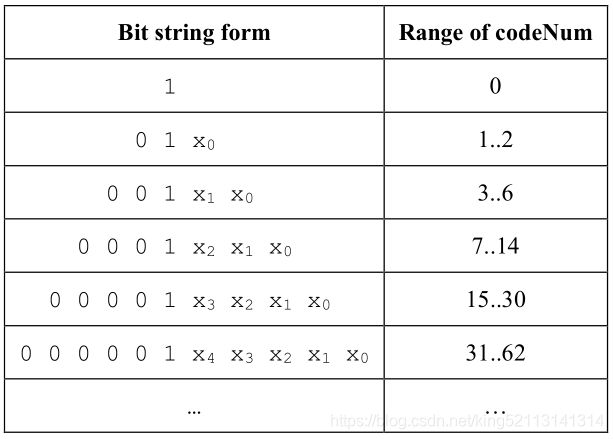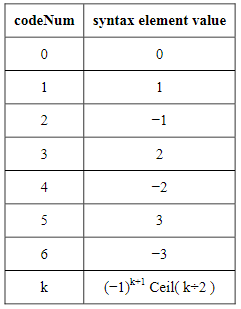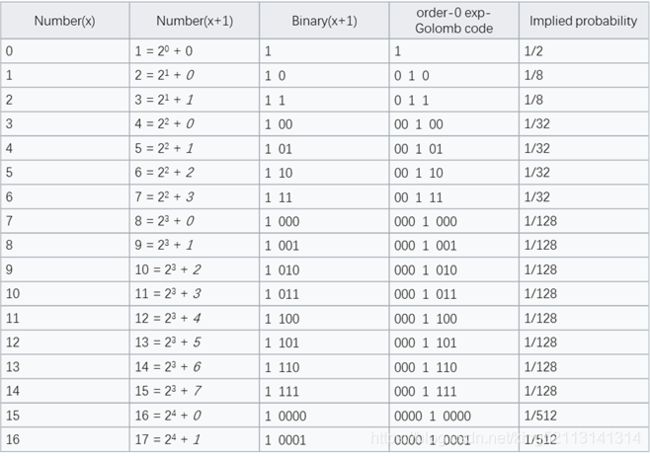Exp-Golomb指数哥伦布解码和编码
1,【H264/AVC 句法和语义详解】(五):Exp-Golomb指数哥伦布编码(理论篇)
https://blog.csdn.net/u011399342/article/details/80472399
公式如下:
其中leadingZeroBits为1前面,0的个数。所以在解码的时候,如果遇到描述子为ue(v),则可以先数0的个数,数到1为止,其中0的个数即为leadingZeroBits。而公式中的read_bits( leadingZeroBits ),则为从中间1开始,往后顺序数leadingZeroBits个比特位,将这几个比特位所表示的数值返回。
//ue(v)就代表了0阶指数哥伦布编码,通常被称为无符号指数哥伦布编码:
leadingZeroBits = −1
for (b = 0; !b; leadingZeroBits++)
b = read_bits(1)
codeNum = 2^(leadingZeroBits) − 1 + read_bits(leadingZeroBits)
长度=2*leadingZeroBits+1
二进制比特串 长度 0阶指数哥伦布解码值
1001 1 0
001 1001 5 5
01 1010 3 2
010 3 1
000 1011 7 10
0001 001 7 8
利用上述公式,就可以计算出codeNum的值。
x0~x4可表示0或者1
2,Exponential-Golomb decoding
http://guoh.org/lifelog/2013/10/exp-golomb-coding/
对于11110001 01100001 01100010 01100010进行哥伦布解码
过程就是读取1位,在这里结果是1,所以会跳出循环,但是leadingZeroBits++还是会执行,所以leadingZeroBits为0,后面read_bits也不会读取数据了。
codeNum = 2^0 – 1 + 0 = 0
也就是说编码为1的属性实际值为0
seq_parameter_set_id = 0 // Exp-Golomb解11110001中的第一个字码1
3,Se(v)
if the syntax element is coded as se(v), the value of the syntax element is derived by invoking the mapping process for signed Exp-Golomb codes as specified in ue(v) with codeNum as the input.
4,Exponential-Golomb coding
https://en.wikipedia.org/wiki/Exponential-Golomb_coding
0阶哥伦布:
To code a number x ≥ 1:
- Let
 be the highest power of 2 it contains, so
be the highest power of 2 it contains, so  .
. - Write out N zero bits, then
- Append the binary form of (x+1), the binary form of (x+1) is an (N+1)-bit binary number.
An equivalent way to express the same process: To encode any nonnegative integer x using the exp-Golomb code:
- Write down x+1 in binary
- Count the bits written, subtract one, and write that number of starting zero bits preceding the previous bit string.

k阶哥伦布:
To encode larger numbers in fewer bits (at the expense of using more bits to encode smaller numbers), this can be generalized using a nonnegative integer parameter k. To encode a nonnegative integer x in an order-k exp-Golomb code:
第二步的删除前面的K个0,也可以改为在0阶指数哥伦布计算时不在前面写N个0,而是在前面写N-K个0
5,k阶哥伦布解码
leadingZeroBits = −1
for (b = 0; !b; leadingZeroBits++)
b = read_bits(1)
codeNum = 2^(leadingZeroBits + k) − 2^k + read_bits(leadingZeroBits + k)








